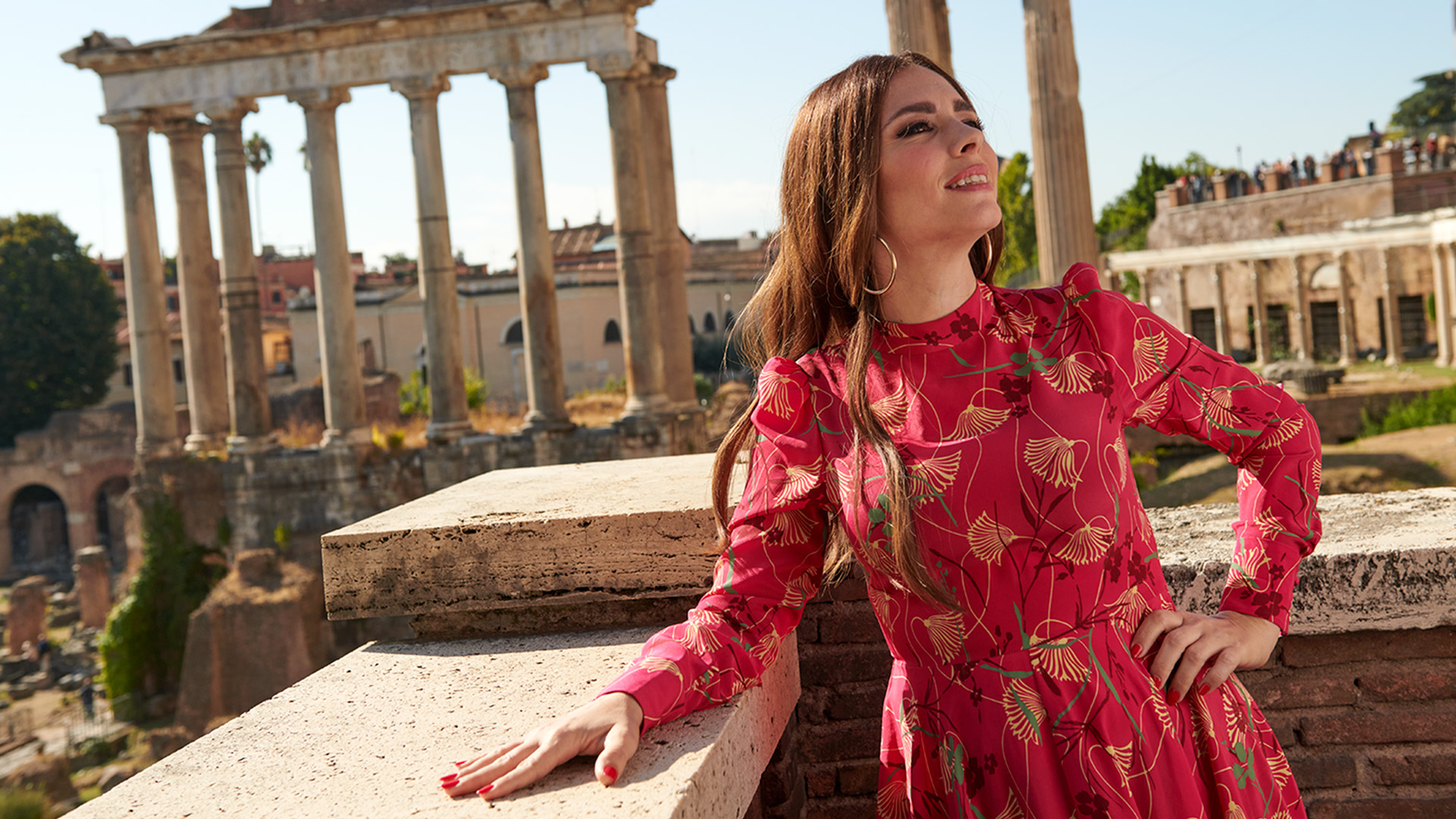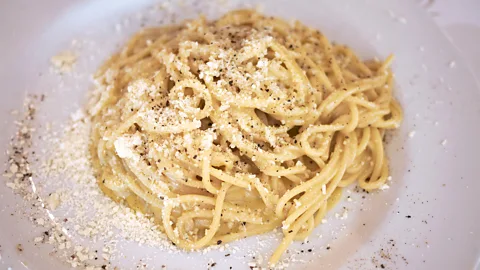The Pasta Queen's favourite cacio e pepe in Rome
 Erica Fava
Erica FavaThe cheesy, peppery pasta dish has become as viral as chef Nadia Munno's cooking videos. Here are her favourite places to get it in her hometown of Rome.
For Roman chef and businesswoman Nadia Caterina Munno – better known to her five million-strong legion of social media followers as "The Pasta Queen" – the rich pasta dish of cacio e pepe, represents everything she loves about her hometown.
"Romans are loud, aggressive, but really friendly. Their friendliness is a form of love," she says. "Roman cuisine is [also] very punchy and aggressive – up [in northern Italy], dishes are more delicate – and cacio e pepe is very traditionally Roman."
Indeed, made by simply tossing pasta, Pecorino cheese, hot pasta water and toasted black peppercorns together, cacio e pepe (literally: "'cheese and pepper") is Roman cuisine par excellence: humble, salty and spontaneous.
In recent years, the dish has become a firm favourite overseas, with restaurants from New York to London proudly serving their versions of the savoury recipe. It has also become one of the main stars of Munno's larger-than-life home cooking videos, which are peppered with a Sophia Loren-esque theatricality and replete with gushing references to the "pasta gods".

New York Times bestselling author Nadia Caterina Munno is a Roman chef and influencer currently based in Clearwater, Florida. In 2024, she became the star of her own Amazon Prime TV show, The Pasta Queen. She is the author of The Art of Italian Cooking: 100+ Recipes from My Family to Yours.
Munno's own royal moniker may pose a rather grand claim, but she's hardly a usurper: she heralds from a family that has been producing pasta for centuries, even garnering the nickname of the "Macaronis".
"To be a 'pasta queen' you have to have an experience and a background: these are the dishes I cooked all my life," she explains. "I want to teach people about the values of Italian food, which bring people together, to enjoy life a bit more."
She adds: "Food shouldn't be treated as an afterthought. Empires were forged on food."
And though Rome's history may be imperial, cacio e pepe – much like other classic Roman pasta dishes like carbonara and amatriciana – is a humble dish, deeply rooted in the city's working class culture, with influences from the nearby shepherds who moved to Rome from the Apennine mountains. What may come to a surprise to some is that cacio e pepe is not even one of the most consumed dishes in the Roman kitchen. Its recent popularity, Munno says, is largely a product of social media marketing.
"It's not as sought after from Romans as from tourists who come to visit the city," Munno notes. "It's definitely traditional, but cacio e pepereally has gone viral, being popularised internationally."
All this notwithstanding, the dish is now a consolidated part of Rome's culinary repertoire, a staple in trattorie and family homes across the city.
Here are Munno's favourite places to get cacio e pepe in Rome.
 Felice a Testaccio
Felice a Testaccio1. Best for eating cacio e pepe like a local: Felice a Testaccio
If there's any restaurant in Rome which can legitimately lay claim to being the "king" of cacio e pepe, it's Felice a Testaccio – and Munno recommends going there to experience the dish like a true local.
Make it at home
While tourists may want to order a cacio e pepe in restaurants, Munno also recommends learning how to make it at home. But the dish's simplicity can also be deceptive: cacio e pepe is notoriously tricky to nail, as the wrong temperature, portions or even timing can leave a gloopy, curdled mess.
"The biggest issue people have is the cheese clumping," Munno says. "To make it creamy, to mix the right way, the biggest tip is to use cheese that is actually Pecorino – the pre-grated form is often made with fillers – and to take it off the heat before you toss it. That way, it isn't too watery or too thick."
"I liked going to [Felice a Testaccio] because I grew up nearby," Munno says. "It's a place which is popular with the local people, and the food is amazing."
For Felice a Testaccio, cacio e pepe is a veritable artform – and one whose creation is displayed to clients, as the mantecatura (emulsification) of the pasta in the Pecorino cheese is performed tableside.
Using fresh tonnarelli (thick spaghetti), Felice a Testaccio's cacio e pepeis decadent, sharp and creamy, the Roman dish in its most sumptuous form.
As its name suggests, Felice is located in the city's scruffy, vibrant Testaccio neighbourhood, which was built on the remains of an ancient Roman trash heap and the port that serviced the city with its food. Today, the neighbourhood maintains its culinary tradition as the location of the monumental Testaccio food market.
"It's one of the main markets of Rome," Munno says.
The district, located south of the city centre, doesn't quite reek of "dolce vita" in the postcard-perfect, Hollywood sense – think less Roman Holiday and more graffitied walls and post-war apartment blocks – but it's as quintessentially Roman as it gets, and Munno recommends sinking your teeth into – and its food.
"The area doesn't get enough love," Munno says. "But it's very Roman."
Website: https://feliceatestaccio.com
Address: Via Mastro Giorgio, 29, 00153
Phone: + 39 06 574 6800
Instagram: @feliceatestaccio
 Getty Images
Getty Images2. Best for a gourmet palate: Roscioli Salumeria con Cucina
When it comes to finding a more refined, gourmet-approved take on Roman cuisine, then Roscioli Salumeria con Cucina is your port of call.
The restaurant – opened near the Campo de' Fiori street market in 1972 and now part of a local chain of bakeries and eateries – offers sophisticated, yet still authentic, takes on classic Roman and other Italian dishes, within an elegant setting that attracts an exclusive clientele. Its ingredients are sourced from the best suppliers, and its cacio e pepe is no exception.
"Roscioli is truly authentic Roman [food]," Munno says. "What they serve is truly amazing."
Using fresh tagliolini pasta, Nepalese black pepper and a touch of extra virgin olive oil to help bind the sauce, Roscioli's cacio e pepe is delicate and refined, yet still full of the tangy saltiness of the traditional Roman recipe.
"It's incredibly gorgeous," Munno says.
Reserve in advance, as bookings can be competitive.
Website: https://www.roscioli.com
Address: Via dei Giubbonari, 21, 00186
Phone: +39 06 687 5287
Instagram: @rosciolisalumeria
 Getty Images
Getty Images3. Best for a cosy experience: Hostaria da Cesare
Hostaria da Cesare, which celebrated its centennial anniversary in 2021, brims with nostalgia, with a distinct "frozen-in-time-feel": a time capsule of what may seem like a bygone era.
Warm, wood-panelled interiors give it a distinctly cosy, mid-century charm. Da Cesare's cacio e pepe – one of the city's best, according to Munno – is traditional and rich, made with spaghetti, coated in a flurry of shaved Pecorino and black pepper.
Conveniently placed in the central Prati quarter, an elegant, 19th-Century Parisian-esque grid of streets close to the Vatican, Hostaria Da Cesare is centrally located but also somewhat shielded from the tourist throngs.
"It isn't particularly touristy, but it's getting more attention," Munno says.
 Getty Images
Getty Images4. Best for date night: Trattoria Da Teo
Trattoria Da Teo doesn't feel like an ordinary restaurant – it feels more like a dining room a family graciously opened up to the public.
Deep in the Trastevere district south of the Vatican, Da Teo is set in a neighbourhood which – in spite of its popularity with tourists – has preserved its medieval charm and a fierce community spirit.
"Trastevere is magical," Munno says. "It's a crazy neighbourhood which gives you a whole different experience [and] energy."
"You have people dancing, clubs, young people, cats," she adds. "The heart and vibe of Rome."
Munno believes Da Teo offers a taste of Trastevere's "intense, exhilarating Roman vibe" and recommends going there with a significant other. "Going [there] with a lover is so romantic," she says.
Tossed in an especially thick, creamy homestyle sauce, Da Teo's take on the Roman dish feels less like a restaurant serving and more akin to something your nonna would whip you up for Sunday lunch.
Website: https://m.facebook.com/Trattoria.da.TEO/
Address: Piazza dei Ponziani, 7A, 00153
Phone: +39 06 581 8355
Instagram: @trattoriadateo
 Flavio al Velavevodetto
Flavio al Velavevodetto5. Best for a unique dining experience: Flavio al Velavevodetto
Flavio al Veloavevodetto is perhaps one of the most unique eateries in a city packed with historical oddities, in that it is located quite literally inside an ancient Roman trash heap: the Monte Cocci, a hill made up of discarded amphorae (vases).
"It's an incredible experience you can't get anywhere else," Munno says.
In spite of its remarkable setting, the restaurant nevertheless makes simple, traditional food for a largely local clientele – and, Munno notes, is a great place to experience dishes like cacio e pepe.
"[Flavio] has a typical family style," Munno says. "It isn't super fancy. It's a place for day-to-day Romans, one of those places you can't eat badly."
Flavio al Veloavevodetto serves a cacio e pepe which, as Italians would say, is as dio comanda (God wills it) – using thick tonnarelli and abundant Pecorino.
While Flavio al Veloavevodetto's flagship is in Testaccio, you can also experience their creations over in a more recently opened branch in the more centrally located Prati district. Munno still recommends the original.
"Tourists should come to experience it," she says.
Website: https://www.ristorantevelavevodetto.it
Address: Via di Monte Testaccio, 97, 00153 / Piazza dei Quiriti, 4-5,
Phone: +39 06 574 4194 / +39 06 3600 0009
Instagram: @alvelavevodetto
BBC Travel's The SpeciaList is a series of guides to popular and emerging destinations around the world, as seen through the eyes of local experts and tastemakers.
--
If you liked this story, sign up for The Essential List newsletter – a handpicked selection of features, videos and can't-miss news, delivered to your inbox twice a week.
